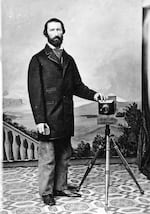Prolific photographer Peter Britt may be best known for taking the first known photograph of Crater Lake in 1874, but many also recognize him as the father of the grape industry in Southern Oregon.

In this image, circa 1860s, photographer Peter Britt stands next to one of his early cameras. His right hand holds a lens cap, which was used as a shutter.
Courtesy of the Oregon Historical Society, CN000266
Britt was born in Switzerland on March 12, 1819. Like thousands of others, he made his way to the American West during the Gold Rush, eventually making his home in the gold camp of Jacksonville, Oregon.
By the mid-1850s, he had opened a portrait studio while also traveling the region, taking thousands of outdoor images.
In 1858, the “Oregon Sentinel” newspaper in Jacksonville reported, “Mr. Britt, of this town, is one of the best artists in Oregon, which may be evidenced by visiting his gallery and inspecting his fine lifelike photographs, melanotypes, ambrotypes and daguerreotypes.”
Unseen photos still waiting to be revealed
Britt also produced thousands of glass plate negatives, including about 6,000 that are only now being digitized by the Southern Oregon Historical Society.
SOHS archivist Jan Wright said the unprocessed negatives hold a treasure trove of images. “Jacksonville was one of the most photographed towns in Oregon because he took his camera out on many occasions. You can see the development from the Chinatown quarters to the brick courthouse. Everything was just so well documented.”
The photos that helped create Crater Lake National Park
In August 1874, Britt used a wagon to haul 200 pounds of photographic equipment up the rim of Crater Lake, capturing the first known photograph of the now-famous landmark.
He had tried the same trip in 1868 but couldn’t reach the rim. A year later, he provided another local photographer with equipment in yet a second failed attempt to capture an image of the lake.
After finally successfully scaling the mountain and photographing Crater Lake, Britt continued making the climb over the next several years, taking the images that would help convince the federal government to make the area a national park.

This photograph, taken by Peter Britt in 1874, is the first known successful photograph ever taken of Crater Lake.
Courtesy of the Southern Oregon Historical Society
The first commercial winery in Oregon
Britt is also remembered for his contributions to the wine industry. In the 1850s, he planted some of the region’s first grapevines, and by 1880, he was producing up to 3,000 gallons of wine per year. His business, Valley View Vineyard, is thought to be the first commercial winery in the state of Oregon.
The “Oregon Sentinel” newspaper reported in 1877, “At Mr. Britt’s place, we tasted a one-year-old claret of his own growth and manufacture, and we very much doubt it can be surpassed in the much boasted-of California vineyards.”
Peter Britt died in 1905. In 1963, the annual Peter Britt Music Festival opened on the grounds of the Britt home, where it continues to operate today.

“Oregon Experience” behind the scenes
Last spring, while interviewing Southern Oregon Historical Society archivist Jan Wright for “Oregon’s County Poor Farms,” she showed us some of the thousands of delicate glass plate negatives waiting to be digitized and processed into the library’s computer system. It’s a slow process requiring careful work. At the time, SOHS was applying for grants to help with the process. Now, some of the grant money has come through. As images are processed and made available, we will highlight some of the rediscovered treasures.
Additional Peter Britt images can be viewed at the Hannon Library, Special Collections & Archives on the Southern Oregon University website.
